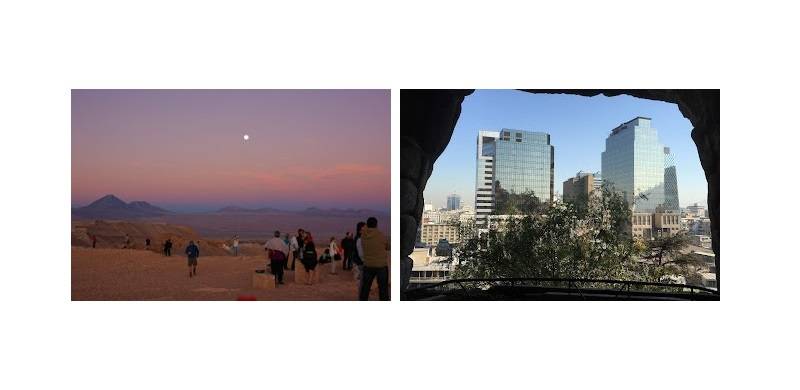
In the darkness of the early morning hours, a driver and tour guide were taking us up the High Andes of Chile in a small German-made SUV. Our destination was a place called El Tatio, which has one of the largest collections of geysers in Latin America.
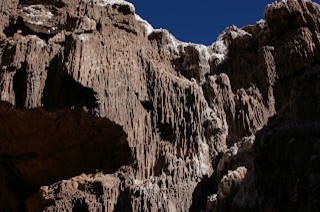 We had read that the geysers put on their best showing at sunrise, sending plumes of steam to heights in excess of 30 meters. The journey had begun in Santiago, from where we had flown into San Pedro de Atacama, which was at an altitude of 2,407 meters. It had taken us a couple of days to get acclimatized to the elevation. We wondered how we would cope with El Tatio, which was at an altitude of 4,320 meters.
We had read that the geysers put on their best showing at sunrise, sending plumes of steam to heights in excess of 30 meters. The journey had begun in Santiago, from where we had flown into San Pedro de Atacama, which was at an altitude of 2,407 meters. It had taken us a couple of days to get acclimatized to the elevation. We wondered how we would cope with El Tatio, which was at an altitude of 4,320 meters.
The road was windy and steep. After one bend in the road, I spotted a bright object in front of us, about half way up in the sky. It was so bright that I thought it was a plane. The guide said it was Venus, the morning star.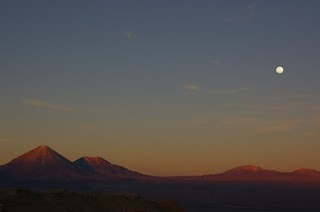
The reason why we had come to Atacama was to see the Milky Way and the constellations. Atacama was supposed to be the driest place on earth and was famous for its exceptionally clear night skies. But the first person we met at the Noi Casa hotel told us that stargazing would not be the thing to do. Seeing the puzzled look on my face, he said the “problem” was the full moon. Two others told us the same thing. So, we resigned ourselves to seeing nothing in the night sky.
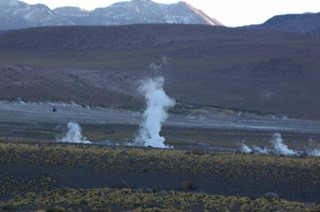 The tempo changed as evening fell over the village. Atacama was lit up brilliantly by the full moon. You could see all the craters on the lunar surface with the naked eye. It no longer mattered that you could not see any other objects in the sky.
The tempo changed as evening fell over the village. Atacama was lit up brilliantly by the full moon. You could see all the craters on the lunar surface with the naked eye. It no longer mattered that you could not see any other objects in the sky.
The next evening, we went on a tour of the Valley of the Moon. The soil and the surrounding mountains were rendered red by the declining sun. Before sunset, we explored a cave. And then, half an hour before sunset, we drove to a site where the valley could be viewed in full.
As the full moon began to rise, it painted the volcanoes into a rich tapestry. The hues and colors seemed to change by the minute. At one point the entire sky was rendered a surreal orange.
Several people were there – dumbstruck – and compelled to take pictures with whatever instruments they had, mostly with their cell phones.
The following morning, we were heading to see the sunrise light up the geysers.
As we emerged from the SUV, the frigid cold air hit us. It was several degrees below freezing. Thankfully, there was no wind. The geysers were active. You could hear them but not see them.
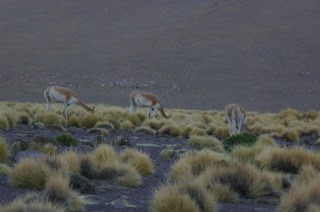 Suddenly, the sun rose over the mountains and lit up the geysers. It was the most incredible display of nature’s powers.
Suddenly, the sun rose over the mountains and lit up the geysers. It was the most incredible display of nature’s powers.
We wandered between the various geyser pools and witnessed the hissing and gurgling sounds up close.We were told a Frenchman had died a few years ago at one of the geyser pools. He was trying to take a picture and had fallen into the boiling water. Further out, there was a swimming pool where some people were enjoying a swim. The guide said the real excitement does not occur in the pool but outside the pool, when they emerge from the pool and their skin encounters the freezing air.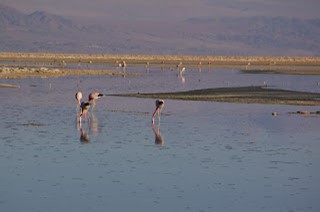
On the way back to Atacama, we spotted several guanacos (wild llamas) on the hills. Because of the thin air, “a teaspoon of guanaco blood contains about 68 billion red blood cells – four times that of a human.”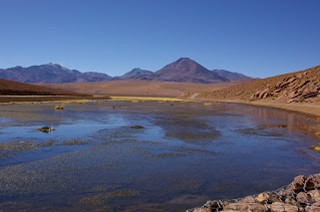
Further along, we came across a lake and stopped to see the reflections of the volcanoes. A few seabirds and ducks were playing in the water.
On the following day, we went to see the flamingos. There were not many but the few that were there provided an incredible photo-op, being reflected in the salt lakes and being silhouetted by the volcanoes.
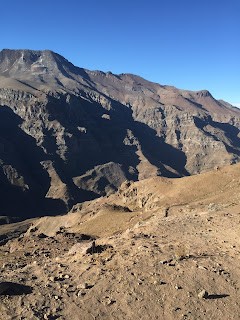
Valle Nevado
On a prior trip, we had taken a tour bus up to Valle Nevado, a famed ski resort. The view at the ski resort was stark, reminiscent of some of the scenes in the movie, Interstellar. There was no snow. The glaciers had receded. Even the air was still. We were told that Chile was deep into a drought.
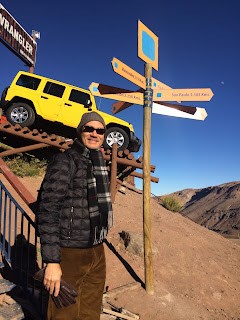 Our journey had begun in Santiago and we had reached the ski resort in just an hour. To get there, we traversed a road with more than thirty switchbacks.
Our journey had begun in Santiago and we had reached the ski resort in just an hour. To get there, we traversed a road with more than thirty switchbacks.
Santiago
We had flown into Santiago just as the rising sun was lighting up the High Andes. That was the most spectacular approach and landing that I had ever experienced. The city was spread out over a large area. As we approached the downtown area, one building stood out head and shoulders above the rest. We were told it was the Costanera Tower, the tallest skyscraper in Latin America. On our second visit, we got to go up to the top of the tower and take in the sweeping view of the city that lay underneath.
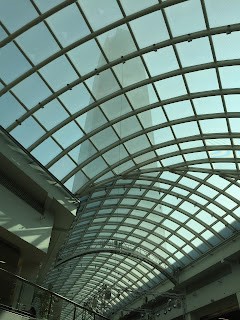
On the first visit, we had to settle for the view from the top of Cerro San Cristobal. To get there, you had to board a rickety and shaky funicular that dated back to 1925. The wait was almost a half hour, in part because the first stop along the climb was the city zoo. But it was worth the wait. The city views were sweeping in every direction. At the top was the gleaming white statue of the Virgen de la Inmaculada Concepción. A smaller statue of Pope John Paul II was also there, commemorating his visit.
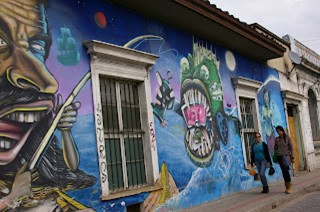 In Santiago, we had explored many fine museums, markets and restaurants. Our hotel was located in an area known as Las Condes. An Italian restaurant across the street, Tiramisu, offered exceptional dishes and was always busy. It was not just the pizza that was phenomenal. So was its atmosphere. The vibe was very contemporary and the service was slow, letting the guests relax and enjoy the rhythm of Chile.
In Santiago, we had explored many fine museums, markets and restaurants. Our hotel was located in an area known as Las Condes. An Italian restaurant across the street, Tiramisu, offered exceptional dishes and was always busy. It was not just the pizza that was phenomenal. So was its atmosphere. The vibe was very contemporary and the service was slow, letting the guests relax and enjoy the rhythm of Chile.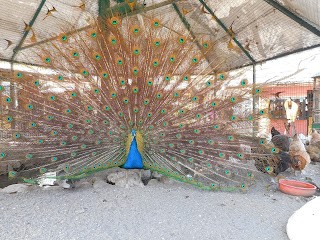
Elsewhere, we saw traditional art painted on walls and elegant buildings. We toured the structures atop Cerro Santa Lucia and also took in the views that the mountain offered of the city. Both were magnificent. The place was steeped in history. Apparently, the city had fallen to its Spanish conquerors from this hill.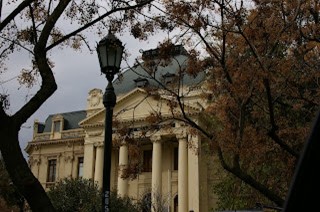
The two-storied and multi-sectioned house of the writer and Nobel laureate, Pablo Neruda, could have come from a movie set.
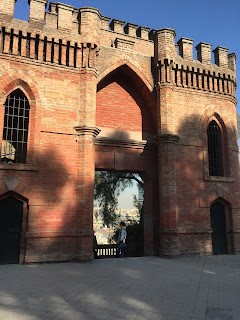 It was brimming with artifacts gathered from his postings as Chile’s ambassador to places around the globe including Burma, Ceylon and Singapore. According to a biography, the Colombian novelist Gabriel Garcia Marquez called him “the greatest poet of the 20th century in any language and Harold Bloom, the American literary critic, included him as one of the 26 writers who were central to the western literary tradition.
It was brimming with artifacts gathered from his postings as Chile’s ambassador to places around the globe including Burma, Ceylon and Singapore. According to a biography, the Colombian novelist Gabriel Garcia Marquez called him “the greatest poet of the 20th century in any language and Harold Bloom, the American literary critic, included him as one of the 26 writers who were central to the western literary tradition.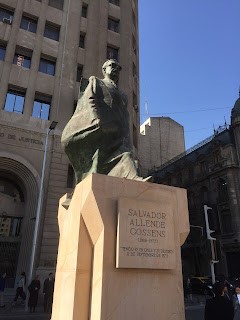
The military academy lay within the city limits. The day we stopped by was one where a big outside party was being held in white tents that had been put up on the lawn. Smoke was rising from the barbeques. Entry was limited to military personnel and their guests and we were not allowed in. Photography was strictly forbidden. All of this was a surprise to me, since I had toured West Point in New York and the Citadel in South Carolina with ease. In Chile, you have to be officially invited.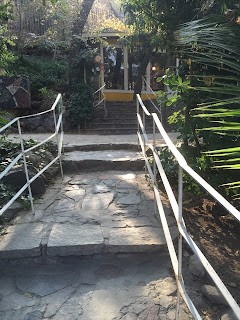
Prussian influence runs deep and long in the Chilean army, as evidenced by the uniforms and marching style of the troops.
Chile was ruled by a junta headed by General Augusto Pinochet from 1973 to 1990. During that time numerous citizens were arrested, tortured and killed. Their sacrifices are aptly captured at the Museum of Memories.
The Presidential Palace is grand and sweeping. A s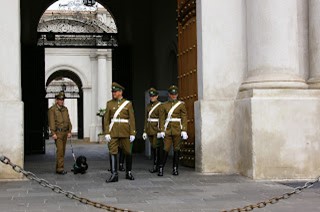 tatue of President Salvador Allende, killed during Pinochet’s coup, stands on the side of the courtyard.
tatue of President Salvador Allende, killed during Pinochet’s coup, stands on the side of the courtyard.
The Plaza de Armas is n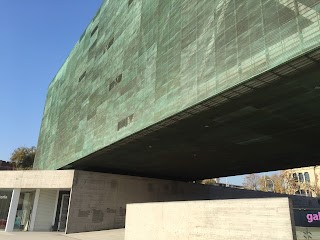 nd other events. It is also the site of the main cathedral.
nd other events. It is also the site of the main cathedral.
And then there was an arts and crafts market where you could buy just about anything that you wanted to bring home for friends and family. In a cage, to entertain you, there was a peacock who fanned his feathers for us in a very warm welcome.
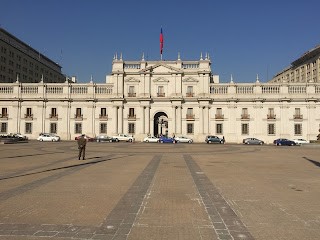
Valparaiso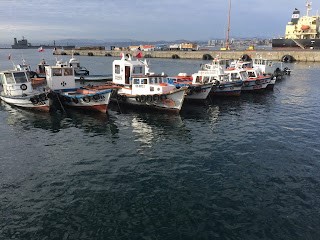
The beach town is an hour and a half away from Santiago. It is the site of a major seaport which was the biggest port in Latin America prior to the opening of the Panama Canal. The headquarters of the armada was very impressive. We did a harbour cruise and got up close to several warships of the Chilean navy. A quick Google search revealed that the frigates had an eclectic pedigree, being of British, French, and Spanish origin. That must pose complexities for the maintenance crew, I thought, but supplier diversity also has its pluses. Fishing boats were anchored across the channel. And the submarines were home-ported south of Valparaiso.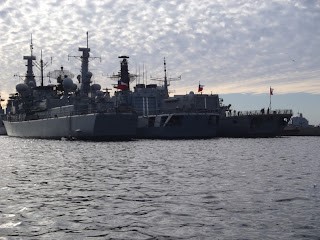
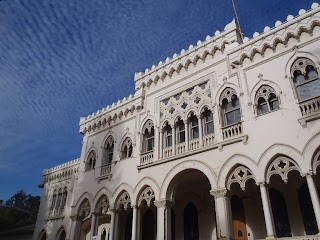 Not too far inland is an old mansion inside a large park. The mansion was damaged during the earthquake of 2010. It’s shut down and the cracks caused by the quake are easily visible on the façade of the structure.
Not too far inland is an old mansion inside a large park. The mansion was damaged during the earthquake of 2010. It’s shut down and the cracks caused by the quake are easily visible on the façade of the structure.
There is so much more to see in Chile. At the southern tip lies the famed Patagonia, a highly frequented destination for tourists, and a launching base for those who are brave enough to head to Antarctica. Someday we hope to go there.
 We had read that the geysers put on their best showing at sunrise, sending plumes of steam to heights in excess of 30 meters. The journey had begun in Santiago, from where we had flown into San Pedro de Atacama, which was at an altitude of 2,407 meters. It had taken us a couple of days to get acclimatized to the elevation. We wondered how we would cope with El Tatio, which was at an altitude of 4,320 meters.
We had read that the geysers put on their best showing at sunrise, sending plumes of steam to heights in excess of 30 meters. The journey had begun in Santiago, from where we had flown into San Pedro de Atacama, which was at an altitude of 2,407 meters. It had taken us a couple of days to get acclimatized to the elevation. We wondered how we would cope with El Tatio, which was at an altitude of 4,320 meters.The road was windy and steep. After one bend in the road, I spotted a bright object in front of us, about half way up in the sky. It was so bright that I thought it was a plane. The guide said it was Venus, the morning star.

The reason why we had come to Atacama was to see the Milky Way and the constellations. Atacama was supposed to be the driest place on earth and was famous for its exceptionally clear night skies. But the first person we met at the Noi Casa hotel told us that stargazing would not be the thing to do. Seeing the puzzled look on my face, he said the “problem” was the full moon. Two others told us the same thing. So, we resigned ourselves to seeing nothing in the night sky.
 The tempo changed as evening fell over the village. Atacama was lit up brilliantly by the full moon. You could see all the craters on the lunar surface with the naked eye. It no longer mattered that you could not see any other objects in the sky.
The tempo changed as evening fell over the village. Atacama was lit up brilliantly by the full moon. You could see all the craters on the lunar surface with the naked eye. It no longer mattered that you could not see any other objects in the sky.The next evening, we went on a tour of the Valley of the Moon. The soil and the surrounding mountains were rendered red by the declining sun. Before sunset, we explored a cave. And then, half an hour before sunset, we drove to a site where the valley could be viewed in full.
As the full moon began to rise, it painted the volcanoes into a rich tapestry. The hues and colors seemed to change by the minute. At one point the entire sky was rendered a surreal orange.

Several people were there – dumbstruck – and compelled to take pictures with whatever instruments they had, mostly with their cell phones.
The following morning, we were heading to see the sunrise light up the geysers.
As we emerged from the SUV, the frigid cold air hit us. It was several degrees below freezing. Thankfully, there was no wind. The geysers were active. You could hear them but not see them.
 Suddenly, the sun rose over the mountains and lit up the geysers. It was the most incredible display of nature’s powers.
Suddenly, the sun rose over the mountains and lit up the geysers. It was the most incredible display of nature’s powers.We wandered between the various geyser pools and witnessed the hissing and gurgling sounds up close.We were told a Frenchman had died a few years ago at one of the geyser pools. He was trying to take a picture and had fallen into the boiling water. Further out, there was a swimming pool where some people were enjoying a swim. The guide said the real excitement does not occur in the pool but outside the pool, when they emerge from the pool and their skin encounters the freezing air.

On the way back to Atacama, we spotted several guanacos (wild llamas) on the hills. Because of the thin air, “a teaspoon of guanaco blood contains about 68 billion red blood cells – four times that of a human.”

Further along, we came across a lake and stopped to see the reflections of the volcanoes. A few seabirds and ducks were playing in the water.
On the following day, we went to see the flamingos. There were not many but the few that were there provided an incredible photo-op, being reflected in the salt lakes and being silhouetted by the volcanoes.

Valle Nevado
On a prior trip, we had taken a tour bus up to Valle Nevado, a famed ski resort. The view at the ski resort was stark, reminiscent of some of the scenes in the movie, Interstellar. There was no snow. The glaciers had receded. Even the air was still. We were told that Chile was deep into a drought.
 Our journey had begun in Santiago and we had reached the ski resort in just an hour. To get there, we traversed a road with more than thirty switchbacks.
Our journey had begun in Santiago and we had reached the ski resort in just an hour. To get there, we traversed a road with more than thirty switchbacks.Santiago
We had flown into Santiago just as the rising sun was lighting up the High Andes. That was the most spectacular approach and landing that I had ever experienced. The city was spread out over a large area. As we approached the downtown area, one building stood out head and shoulders above the rest. We were told it was the Costanera Tower, the tallest skyscraper in Latin America. On our second visit, we got to go up to the top of the tower and take in the sweeping view of the city that lay underneath.

On the first visit, we had to settle for the view from the top of Cerro San Cristobal. To get there, you had to board a rickety and shaky funicular that dated back to 1925. The wait was almost a half hour, in part because the first stop along the climb was the city zoo. But it was worth the wait. The city views were sweeping in every direction. At the top was the gleaming white statue of the Virgen de la Inmaculada Concepción. A smaller statue of Pope John Paul II was also there, commemorating his visit.
 In Santiago, we had explored many fine museums, markets and restaurants. Our hotel was located in an area known as Las Condes. An Italian restaurant across the street, Tiramisu, offered exceptional dishes and was always busy. It was not just the pizza that was phenomenal. So was its atmosphere. The vibe was very contemporary and the service was slow, letting the guests relax and enjoy the rhythm of Chile.
In Santiago, we had explored many fine museums, markets and restaurants. Our hotel was located in an area known as Las Condes. An Italian restaurant across the street, Tiramisu, offered exceptional dishes and was always busy. It was not just the pizza that was phenomenal. So was its atmosphere. The vibe was very contemporary and the service was slow, letting the guests relax and enjoy the rhythm of Chile.
Elsewhere, we saw traditional art painted on walls and elegant buildings. We toured the structures atop Cerro Santa Lucia and also took in the views that the mountain offered of the city. Both were magnificent. The place was steeped in history. Apparently, the city had fallen to its Spanish conquerors from this hill.

The two-storied and multi-sectioned house of the writer and Nobel laureate, Pablo Neruda, could have come from a movie set.
 It was brimming with artifacts gathered from his postings as Chile’s ambassador to places around the globe including Burma, Ceylon and Singapore. According to a biography, the Colombian novelist Gabriel Garcia Marquez called him “the greatest poet of the 20th century in any language and Harold Bloom, the American literary critic, included him as one of the 26 writers who were central to the western literary tradition.
It was brimming with artifacts gathered from his postings as Chile’s ambassador to places around the globe including Burma, Ceylon and Singapore. According to a biography, the Colombian novelist Gabriel Garcia Marquez called him “the greatest poet of the 20th century in any language and Harold Bloom, the American literary critic, included him as one of the 26 writers who were central to the western literary tradition.
The military academy lay within the city limits. The day we stopped by was one where a big outside party was being held in white tents that had been put up on the lawn. Smoke was rising from the barbeques. Entry was limited to military personnel and their guests and we were not allowed in. Photography was strictly forbidden. All of this was a surprise to me, since I had toured West Point in New York and the Citadel in South Carolina with ease. In Chile, you have to be officially invited.

Prussian influence runs deep and long in the Chilean army, as evidenced by the uniforms and marching style of the troops.
Chile was ruled by a junta headed by General Augusto Pinochet from 1973 to 1990. During that time numerous citizens were arrested, tortured and killed. Their sacrifices are aptly captured at the Museum of Memories.
The Presidential Palace is grand and sweeping. A s
 tatue of President Salvador Allende, killed during Pinochet’s coup, stands on the side of the courtyard.
tatue of President Salvador Allende, killed during Pinochet’s coup, stands on the side of the courtyard.The Plaza de Armas is n
 nd other events. It is also the site of the main cathedral.
nd other events. It is also the site of the main cathedral.And then there was an arts and crafts market where you could buy just about anything that you wanted to bring home for friends and family. In a cage, to entertain you, there was a peacock who fanned his feathers for us in a very warm welcome.

Valparaiso

The beach town is an hour and a half away from Santiago. It is the site of a major seaport which was the biggest port in Latin America prior to the opening of the Panama Canal. The headquarters of the armada was very impressive. We did a harbour cruise and got up close to several warships of the Chilean navy. A quick Google search revealed that the frigates had an eclectic pedigree, being of British, French, and Spanish origin. That must pose complexities for the maintenance crew, I thought, but supplier diversity also has its pluses. Fishing boats were anchored across the channel. And the submarines were home-ported south of Valparaiso.

 Not too far inland is an old mansion inside a large park. The mansion was damaged during the earthquake of 2010. It’s shut down and the cracks caused by the quake are easily visible on the façade of the structure.
Not too far inland is an old mansion inside a large park. The mansion was damaged during the earthquake of 2010. It’s shut down and the cracks caused by the quake are easily visible on the façade of the structure.***
There is so much more to see in Chile. At the southern tip lies the famed Patagonia, a highly frequented destination for tourists, and a launching base for those who are brave enough to head to Antarctica. Someday we hope to go there.


